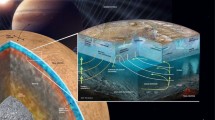Abstract
Analysis of the luni-solar tidal perturbations of the inclination of GEOS-1 (1965-89A,i=59°) and GEOS-2 (1968-002A,i=106°.) has yielded the valuesk 2=0.22 (σ=0.02) and 0.31 (σ=0.01) respectively for the apparent second degree Love number. For GEOS-1 a new purely numerical method involvingosculating elements was employed. For GEOS-2 it was necessary to analyze the variations of themean elements because of the very long period (450 days) of the dominant solar tidal perturbation. An additional analysis of the variation of the mean elements of GEOS-1 confirmed the value ofk 2 obtained from the osculating elements. The disparate values indicate that the simple 2nd degree zonal harmonic model of the tidal potential employed by ourselves and all other investigators is accommodating other effects in addition to those caused by the solid Earth tides. A recent paper by Lambecket al. (1973) indicates that ocean tide effects have significant perturbations on satellite orbits and cannot be neglected.
Similar content being viewed by others
References
Anderle, R. J.: 1971, NWL Technical Report No. TR-2889, U.S. Naval Weapons Laboratory, Dahlgren, Va.
Douglas, B. C., Marsh, J. G., and Mullins, N. E.: 1973,Celes. Mech. 7, 195.
Douglas, B. C., Klosko, S. M., Marsh, J. G., and Williamson, R. G.: 1972, ‘Tidal Effects on the Orbits of GEOS-1 and GEOS-2,’ Goddard Space Flight Center Document No. X-553-72-475.
Gaposchkin, E. M. and Lambeck, K.: 1970, ‘1969 Smithsonian Standard Earth II’, SAO Special Report No. 315, Smithsonian Astrophysical Observatory, Cambridge, Mass.
Kaula, W. M.: 1969,Astron. J. 74, 1108.
Kozai, Y.: 1968,Bull. Geodes. 89, 355.
Lambeck, K., Cazenave, A., and Balmino, G.: 1973, ‘Solid Earth and Fluid Tides from Satellite Orbit Analyses’, Paper presented at the First International Symposium on the Use of Artificial Satellites for Geodesy and Geodynamics, COSPAR, Athens.
Marsh, J. G. and Douglas, B. C.: 1971,Celes. Mech. 4, 309.
Marsh, J. G., Douglas, B. C., and Klosko, S. M.: 1971, ‘A Unified Set of Tracking Station Coordinates Derived from Geodetic Satellite Tracking Data’, GSFC Document No. X0553-71-370, Goddard Space Flight Center, Greenbelt, Maryland.
Martin, T. V.: 1972, ‘GEODYN Systems Operation Description’, Wolf Research and Development Corporation Final Report on Contract No. NAS 5-11736 MOD 129, Riverdale, Maryland.
Newton, R.: 1968,Geophys. J. Roy. Astron. Soc. 14, 505.
Smith, D. E., Kolenkiewicz, R., Plotkin, H. H., Johnson, T., and Dunn, P. J.: 1972, ‘Evidence of Polar Motion from Laser Tracking of Artificial Satellites’, Paper presented at the Astrodynamics and Geodynamics Conference, Goddard Space Flight Center, Greenbelt, Maryland.
Author information
Authors and Affiliations
Rights and permissions
About this article
Cite this article
Douglas, B.C., Klosko, S.M., Marsh, J.G. et al. Tidal parameters from the variation of inclination of GEOS-1 and GEOS-2. Celestial Mechanics 10, 165–178 (1974). https://doi.org/10.1007/BF01227616
Received:
Issue Date:
DOI: https://doi.org/10.1007/BF01227616




